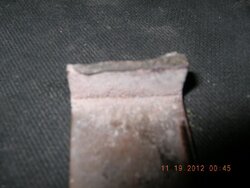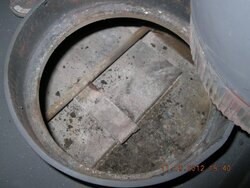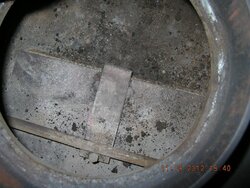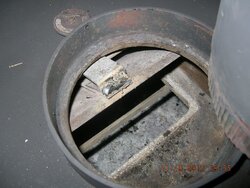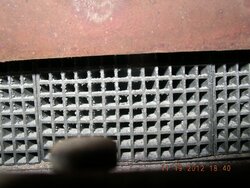I burn some pretty crappy wood. Willow, red cedar, cottonwood, I'm not picky about species. Anything less than 24 hours on a low setting and with a full firebox is abnormal. The cycling and temps sound pretty normal but the rapid wood consumption is not right. How are you deciding that you are out of wood? I get 24 hours from when cat goes active to cat going inactive. Seems to be a pretty dependable way to measure burn time.
2012-2013 Blaze King Performance Thread(everything BK)
- Thread starter rdust
- Start date
-
Active since 1995, Hearth.com is THE place on the internet for free information and advice about wood stoves, pellet stoves and other energy saving equipment.
We strive to provide opinions, articles, discussions and history related to Hearth Products and in a more general sense, energy issues.
We promote the EFFICIENT, RESPONSIBLE, CLEAN and SAFE use of all fuels, whether renewable or fossil. -
Super Cedar firestarters 30% discount Use code Hearth2024 Click here
You are using an out of date browser. It may not display this or other websites correctly.
You should upgrade or use an alternative browser.
You should upgrade or use an alternative browser.
- Status
- Not open for further replies.
phatline
New Member
I burn some pretty crappy wood. Willow, red cedar, cottonwood, I'm not picky about species. Anything less than 24 hours on a low setting and with a full firebox is abnormal. The cycling and temps sound pretty normal but the rapid wood consumption is not right. How are you deciding that you are out of wood? I get 24 hours from when cat goes active to cat going inactive. Seems to be a pretty dependable way to measure burn time.
I call it "out" when there's no longer sufficient coals to start up a new fire by just throwing fresh logs on (I'll have to add kindling to get the new load started). So it's not totally out of wood, but close. That's definitely before the cat goes inactive, but right near the bottom of the dial, and the cat generally goes inactive while I have the door open. For the 9 hour burn I mentioned, I'd guess there was enough wood left to go an hour or two before the cat would go inactive--so I could be generous and call it a 12 hour burn on #1.25.
I agree this burn time seems less than expected at that low setting (and correspondingly low heat output). Right now I'm 8 hours into my oak load, also at #1.25, 285F stovetop temp. The load looks to be at least 2/3 burned down. Cat is low (10 o'clock) but active, and there's no smoke coming out the chimney--although at this burn rate I can't even see the hot exhaust coming out the chimney!
If you guys can think of another test I should run, I'd be happy to do it. I got a draft gauge but still trying to decide where to tap the flue. I guess I could tap a couple heights and compare.
EDIT: the oak load was only about 3/4 full, I'm not an expert at packing the firebox yet. I always load N/S because it's easier to fill that way.
Ok..
I welded her up right in the stove.
I had to use my little flux core mig because it runs on 120.
I am disappointed because there hardly is any weight on the thing..never should have broke.
Here's some pics I know my weld aint purty but it sorta was a pain.
The stove is just starting it's third year.
I might contact BK on this and see if they will give me a deal on a back up cat.
I also want to know why my dealer said that they won't drop ship gaskets and other parts.
I had to pay 10 shipping on that cat gasket then drive 40 mins one way to pick it up!
That was a few weeks ago when I changed out the shot gasket.
I welded her up right in the stove.
I had to use my little flux core mig because it runs on 120.
I am disappointed because there hardly is any weight on the thing..never should have broke.
Here's some pics I know my weld aint purty but it sorta was a pain.
The stove is just starting it's third year.
I might contact BK on this and see if they will give me a deal on a back up cat.
I also want to know why my dealer said that they won't drop ship gaskets and other parts.
I had to pay 10 shipping on that cat gasket then drive 40 mins one way to pick it up!
That was a few weeks ago when I changed out the shot gasket.
Attachments
Monosperma
Member
If you really want to know what your t-stat is doing you need to take the cover off it and watch it.
It won't affect the burn or hurt anything..mine is always off now.
I recommend that to all bk owners to get a grip on it.
What a great tip this has been for me!
It was not easy, given the short clearance between the back wall and the square-drive screws that (since I could not really see them) appeared to be Phillips heads, but I figured it out and got the cover off. My greatest insight has been that my control knob was slipping some on the thermostat control rod. It's hard to describe, since it did catch with regularity at certain points, and slipped with regularity at others. Bottom line: my stove was going out below the 2 setting, and I observed that with a cold stove, at 2 the air intake was still closed. Now, the intake has a small hole in it so the air is never COMPLETELY cut off, but it was reduced enough to kill the fire. I had been rather gentle with the control nob, never forcing it beyond the low range of below 1 and the high range of 3 1/2. But I discovered that the knob is threaded and I was able to screw it down a full turn more, so no more slipping. By the way, the stove was a Craigslist find, so it is possible and plausible that someone UN-screwed the knob a full turn before I owned it. I'm going to be able to do a little fine-tuning, but where 2 used to be, I have now set at a little below 1.
Oh by the way, "it won't affect the burn or hurt anything (to take the cover off): when I did a hot reload, some smoke fed up the primary (low) air intake and out into the room, so I will leave the cover off for an observation period, but I sure as he ll am going to put it back on after a few burn cycles. Anyway, thank you, thank you, for the idea to do this most useful exercise.
No problem!What a great tip this has been for me!
It was not easy, given the short clearance between the back wall and the square-drive screws that (since I could not really see them) appeared to be Phillips heads, but I figured it out and got the cover off. My greatest insight has been that my control knob was slipping some on the thermostat control rod. It's hard to describe, since it did catch with regularity at certain points, and slipped with regularity at others. Bottom line: my stove was going out below the 2 setting, and I observed that with a cold stove, at 2 the air intake was still closed. Now, the intake has a small hole in it so the air is never COMPLETELY cut off, but it was reduced enough to kill the fire. I had been rather gentle with the control nob, never forcing it beyond the low range of below 1 and the high range of 3 1/2. But I discovered that the knob is threaded and I was able to screw it down a full turn more, so no more slipping. By the way, the stove was a Craigslist find, so it is possible and plausible that someone UN-screwed the knob a full turn before I owned it. I'm going to be able to do a little fine-tuning, but where 2 used to be, I have now set at a little below 1.
Oh by the way, "it won't affect the burn or hurt anything (to take the cover off): when I did a hot reload, some smoke fed up the primary (low) air intake and out into the room, so I will leave the cover off for an observation period, but I sure as he ll am going to put it back on after a few burn cycles. Anyway, thank you, thank you, for the idea to do this most useful exercise.
I have never seen smoke come out of mine back there..you must have had a back draft.
Look..the position where the t stat closes will depend on the temp of the stove.
If the stove is very hot it maybe closed at 2 or a little over,,,if it is cold it may not be shut until 1.5 or a little lower.
Of course if the knob is lose that would mess it all up.
You should leave it off long enough to see how it reacts at least.
You will find it is lazy for the most part..but not a big deal at all..it does work,just not as sensitive to temp change has most think.
I get a clunk when the bypass first drops shut, then a snap/clink sound (and feeling) when it locks in on my new Princess.
An update: last night I ran a test with a full load of cedar. I used just the cedar because I'm sure that stuff is dry--you can practically light it with a match and no kindling. I started her up at 3pm and lowered down to #1.25 on the thermostat, in increments, by 4:40. Then I let it run. Now this is below the lowest level I'd been successful at before (#1.5). As I expected, the fire "went out", by which I mean there was no visible glow in the firebox and the flue and cat temps started dropping. But something surprising happened a full hour later--the coals started glowing again, and some small wisps of blue flame appeared. The Princess followed this cycle, about an hour "off" and an hour "on", all the while maintaining roughly 300F on the stovetop. There was very little wood left when I went to bed at midnight, so I'd call that a 9 hour burn cycle on #1.25 with very dry, low-BTU wood.
Is this normal for you guys, when burning at a low setting (cycling between on and off)? Or does it indicate I'm having a draft problem?
To diagnose the potential draft problem, I got a Dwyer Mark II manometer. Given my flue gas cools rapidly in the single-wall pipe, any ideas where would be the best place to probe the flue for draft? Obviously I can't get too close to the stovetop without melting the probe tube.
BTW I'm running the same test today with a load of oak. At least a couple of the pieces I put on were damp--didn't measure a fresh split but they were hissing as they started to burn--so I think y'all are right that moisture content could play a role in some of my issues. I think the guy sold me a mixed lot of variously seasoned pieces, because some measure drier than others.
oak takes longer to season so if you have enough wood maybe put the oak aside to season longer, thats what I did my first year, PITA but the wood I did have burned nice, I had a mix of ash, maple, birch and oak, I burned everything but the oak the first year.
Also, where is the cat temp when you turn it down? You shoul;d let the cat get really hot before you turn it way down to 1.25.
N
nate379
Guest
I think we call all agree that it's impossible to accurately compare a Blaze King to another... unless they were sitting side by side in the same house I guess?
Even just based on outside temp, humidity, etc my stove will run differently.
I run my stove at about #1 position (whatever straight up and down is). With the blowers off, that would push a stove top temp of 650-750* with a full load of birch. With the blowers on it sits around 400-500*
I get roughly 12-16hrs on a load.
The cat will go inactive well before the stove is dead cold. That makes sense to me as there is little fuel (smoke) for it when it's just a small pile of coals.
Example today I fed the stove before work at around 0500. It got up to about 10* for a high, and we are at -5* now.
I got home around 1600, and the stove had a fair amount of coals, house was starting to cool a bit, so I turned it all the way up to burn it down before reloading. Ending up falling asleep and got up around 2030. The coals were all burned down, but I just stirred the ash up and it was still plenty warm to get a fresh load of wood to go.
Yes smoke will come out if you remove the cover and have a tight house. Removing the cover pretty much negates the outdoor air kit.
Even just based on outside temp, humidity, etc my stove will run differently.
I run my stove at about #1 position (whatever straight up and down is). With the blowers off, that would push a stove top temp of 650-750* with a full load of birch. With the blowers on it sits around 400-500*
I get roughly 12-16hrs on a load.
The cat will go inactive well before the stove is dead cold. That makes sense to me as there is little fuel (smoke) for it when it's just a small pile of coals.
Example today I fed the stove before work at around 0500. It got up to about 10* for a high, and we are at -5* now.
I got home around 1600, and the stove had a fair amount of coals, house was starting to cool a bit, so I turned it all the way up to burn it down before reloading. Ending up falling asleep and got up around 2030. The coals were all burned down, but I just stirred the ash up and it was still plenty warm to get a fresh load of wood to go.
Yes smoke will come out if you remove the cover and have a tight house. Removing the cover pretty much negates the outdoor air kit.
phatline
New Member
oak takes longer to season so if you have enough wood maybe put the oak aside to season longer, thats what I did my first year, PITA but the wood I did have burned nice, I had a mix of ash, maple, birch and oak, I burned everything but the oak the first year.
Also, where is the cat temp when you turn it down? You shoul;d let the cat get really hot before you turn it way down to 1.25.
I already put an extra year on the oak (guy who sold it to me claimed it was 18 months seasoned when I bought it in fall 2011). Now, unfortunately, I need to burn it. It's fairly dry but I would prefer drier. Maybe I can get a late season delivery of something else and save this oak for next year.
My test burn at #1.25 with the firebox full 3/4 with oak went 13 hours down to a nice solid coal bed. Might have stretched to 14 hours. So assuming I could get the firebox really packed, I might get ~18 hours on #1.25.
The cat temp is usually around 1 or 2 oclock before I start turning it down. The cat temp keeps climbing after I turn down the thermostat, starts glowing orange and and usually tops out somewhere between 2 and 3 oclock before slowly dropping down to a cruising level. FYI my thermostat isn't labeled with temps, it just has five tick marks (where inactive is between marks 1-2, and the rest are in the active zone; mark 3 is at 12 oclock).
N
nate379
Guest
I usually lock the bypass down once the temp is off "inactive".
Run the stove wide open or at #2 till CAT is off inactive, lock it down, let it run for 5-10 mins or so, and then cut the air off. Will cruise at 400-500 stove temp and CAT at around 12-1:00 area (this is with the blowers on)
It would be interesting to have a BK owner run another BKs owners stove for a day or two just to see if their "habits" work as well?
Lot of people on here talk about running the stove on #2 or higher. If I did that with my I would likely melt down the stove, pipe/chimney, paint off walls and go through a crazy amount of wood! Even with the air cut off I have to watch out how much wood I load if it's warmish out.
I mean it's -5* outside and it's 73* in here with the stove running as low as it can.
Run the stove wide open or at #2 till CAT is off inactive, lock it down, let it run for 5-10 mins or so, and then cut the air off. Will cruise at 400-500 stove temp and CAT at around 12-1:00 area (this is with the blowers on)
It would be interesting to have a BK owner run another BKs owners stove for a day or two just to see if their "habits" work as well?
Lot of people on here talk about running the stove on #2 or higher. If I did that with my I would likely melt down the stove, pipe/chimney, paint off walls and go through a crazy amount of wood! Even with the air cut off I have to watch out how much wood I load if it's warmish out.
I mean it's -5* outside and it's 73* in here with the stove running as low as it can.
I got 12 with the first load, I can get a bit longer but with a big house if I need the heat I have to turn the tstat up which lowers my burn time.
What temp is your cat when your burning with the blower on, Im usually in the 1000-1200 range, no matter where its at once the blowers on it settles in that range depending on what kind of wood Im burning. I know the freestanders are usually in the 1600+ range, mine will do that without the blower on.
I run high cat temps evan with the fan going with a normal reload. I can put the t-stat all the way down and only get 12/15 hour burn times. I think it has something to do with us running SS pipe rather than double wall 6 inch like they do on a Princess free standing stove.
I am buring ash and I think that with oak I am gonna get better burn times.
Its just to warm in Minneapolis to burn and waste wood at this time.
I run high cat temps evan with the fan going with a normal reload. I can put the t-stat all the way down and only get 12/15 hour burn times. I think it has something to do with us running SS pipe rather than double wall 6 inch like they do on a Princess free standing stove.
I am buring ash and I think that with oak I am gonna get better burn times.
Its just to warm in Minneapolis to burn and waste wood at this time.
Never thought of that, thats a good theory, hell, Im happy with my burn times anyway, once or twice twice a day now and Ill go three times a day in frigid weather and Im keeping my big house warm and not burning oil.
Lot of people on here talk about running the stove on #2 or higher. If I did that with my I would likely melt down the stove, pipe/chimney, paint off walls and go through a crazy amount of wood! Even with the air cut off I have to watch out how much wood I load if it's warmish out.
I mean it's -5* outside and it's 73* in here with the stove running as low as it can.
On my princess ultra, the stat has a "normal" range marked on it that lies between about 1.75 and 2.25. About a 1/2" window at the midpoint of the physical range of the stat knob. Seems to be calibrated right since I run low and slow at setting between 1.5 and 1.75 depending on outside temp.
Your stove, Nate, seems to burn quite a bit hotter than any other BK here on the forum. With the possibility that the knob can be calibrated on the stat shaft I wonder if yours is off. It makes sense that the "normal" setting of 2 should not be so high as to melt your house down when it is -5 outside on a stove only rated for 1500 SF. Is your door gasket good? your stat click closed at 1.25 when the stove is cold?
For comparison, it was 53 degrees outside last night when I got home and with a full loaded firebox of alder burning at 1.5 my 1700SF house temp peaked out at 77 from a start at 70.
Sure we'll all have slightly different results but the majority are getting the results that BK specs or better.
Good point on that t-stat dial, it could be a little different from stove to stove. I know with a cold stove my t-stat closes completely at #1 but I remember others mentioning theirs closing a little higher. It also opens up all the way at #3.
Monosperma
Member
Actually, last night, I had trouble closing the bypass door. Now that the fire has burned down a good bit, I looked in there and see that a baffle came loose and lodged into where the bypass should be closing. Great, now I have to let her go cold, disconnect the flue, and put it all back together. Then I have to hope it won't come out again. Oh well, at least it'll be a good opportunity to assess creosote and soot, if any.
I'm curious to know about this "baffle" you speak of.Actually, last night, I had trouble closing the bypass door. Now that the fire has burned down a good bit, I looked in there and see that a baffle came loose and lodged into where the bypass should be closing. Great, now I have to let her go cold, disconnect the flue, and put it all back together. Then I have to hope it won't come out again. Oh well, at least it'll be a good opportunity to assess creosote and soot, if any.
I didn't notice any when I just had mine opened up.
Let us know!
The draft probably accounts for the differences too, I know I have to almost turn mine off to really slow the burn down since my draft is so strong. I turned it way down before I left for work and just got home to a half filled box and a warm house, not as warm as when I have it turned up a bit higher but comfortable nonetheless.Good point on that t-stat dial, it could be a little different from stove to stove. I know with a cold stove my t-stat closes completely at #1 but I remember others mentioning theirs closing a little higher. It also opens up all the way at #3.
Monosperma
Member
I'm curious to know about this "baffle" you speak of.
I didn't notice any when I just had mine opened up.
Let us know!
https://www.hearth.com/talk/threads...ne-help-me-id-or-rule-out-a-loose-part.68911/
It's the rectangular piece that has come loose. They have made some changes since my unit rolled off the assembly line, so yours may be rather different.
Thanks!https://www.hearth.com/talk/threads...ne-help-me-id-or-rule-out-a-loose-part.68911/
It's the rectangular piece that has come loose. They have made some changes since my unit rolled off the assembly line, so yours may be rather different.
I ran a old bk like that one for years but it was non cat.
1987 model.
What size gasket is it? Several stove shops around me sell most sized gaskets. Didn't a local shop have the size available?I also want to know why my dealer said that they won't drop ship gaskets and other parts.
I had to pay 10 shipping on that cat gasket then drive 40 mins one way to pick it up!
That was a few weeks ago when I changed out the shot gasket.
I could have bought one of a e-bay and prolly should have.What size gasket is it? Several stove shops around me sell most sized gaskets. Didn't a local shop have the size available?
My thought was to throw the dealer a few bucks and to keep in touch with him.
I duno..I like hearing how Woodstock does things.
Thing was why should I have to pay shipping from wherever to the dealer then have to drive to get it.
I just wanted to pay with my credit card then have it shipped here.
For the life of me I can't figure out why not.
Hell, I'll buy the gasket from a local dealer, throw it in an envelope and get it two you within two days (you aren't far from me) for a lot less money. $10 for shipping on, what should be, $3-4 in gasket material seems harsh.I could have bought one of a e-bay and prolly should have.
My thought was to throw the dealer a few bucks and to keep in touch with him.
I duno..I like hearing how Woodstock does things.
Thing was why should I have to pay shipping from wherever to the dealer then have to drive to get it.
I just wanted to pay with my credit card then have it shipped here.
For the life of me I can't figure out why not.
They charged me 20 for the gasket plus tax then 10 shipping.Hell, I'll buy the gasket from a local dealer, throw it in an envelope and get it two you within two days (you aren't far from me) for a lot less money. $10 for shipping on, what should be, $3-4 in gasket material seems harsh.
Like I said..I'm not happy and wont do it again.
It's 2 inches by something..I forget.
Edit: 30 inches long.
The draft probably accounts for the differences too, I know I have to almost turn mine off to really slow the burn down since my draft is so strong. I turned it way down before I left for work and just got home to a half filled box and a warm house, not as warm as when I have it turned up a bit higher but comfortable nonetheless.
Yep, we haven't had real cold weather yet but I can tell a slight difference in colder windy days. Usually 1.5-1.7 will give me an easy 24 hours on an average 40-50 degree day but the same setting with temps in the 20-30's will have a little shorter burn. I'm sure I'll be dialing down here this Winter to maintain those 24 hour burns.
Yep, we haven't had real cold weather yet but I can tell a slight difference in colder windy days. Usually 1.5-1.7 will give me an easy 24 hours on an average 40-50 degree day but the same setting with temps in the 20-30's will have a little shorter burn. I'm sure I'll be dialing down here this Winter to maintain those 24 hour burns.
Pretty much what I've found since I've owned this stove. When it gets cold the increased draft usually gives me the desired heat output on the same dial setting I use when it's warmer.
- Status
- Not open for further replies.
Similar threads
- Replies
- 2K
- Views
- 134K
- Replies
- 3K
- Views
- 196K
- Replies
- 2K
- Views
- 133K
- Replies
- 2K
- Views
- 155K
- Replies
- 1K
- Views
- 122K


